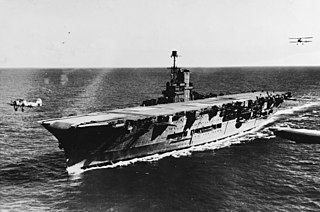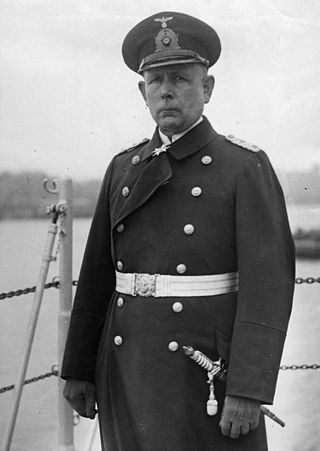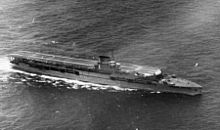
HMS Ark Royal was an aircraft carrier of the Royal Navy that was operated during the Second World War.
HMT Juniper (T123) was a Tree-class minesweeping trawler of the Royal Navy. She was built by Ferguson Brothers Ltd. at Port Glasgow, launched on 15 December 1939, and commissioned on 9 March 1940.

HMS Glorious was the second of the three Courageous-class battlecruisers built for the Royal Navy during the First World War. Designed to support the Baltic Project championed by the First Sea Lord, Lord Fisher, they were relatively lightly armed and armoured. Glorious was completed in late 1916 and spent the war patrolling the North Sea. She participated in the Second Battle of Heligoland Bight in November 1917 and was present when the German High Seas Fleet surrendered a year later.

Admiral Hipper was the lead ship of the Admiral Hipper class of heavy cruisers which served with Nazi Germany's Kriegsmarine during World War II. The ship was laid down at the Blohm & Voss shipyard in Hamburg in July 1935 and launched February 1937; Admiral Hipper entered service shortly before the outbreak of war, in April 1939. The ship was named after Admiral Franz von Hipper, commander of the German battlecruiser squadron during the Battle of Jutland in 1916 and later commander-in-chief of the German High Seas Fleet. She was armed with a main battery of eight 20.3 cm (8 in) guns and, although nominally under the 10,000-long-ton (10,160 t) limit set by the Anglo-German Naval Agreement, actually displaced over 16,000 long tons (16,260 t).
The Norwegian Campaign, lasting from 9 April to 10 June 1940, led to the first direct land confrontation between the military forces of the Allies—the United Kingdom and France— against Nazi Germany in World War II.

The Scharnhorst class was a class of German battleships built immediately prior to World War II. The first capital ships of Nazi Germany's Kriegsmarine, it comprised two vessels: Scharnhorst and Gneisenau. Scharnhorst was launched first, and is considered to be the lead ship by some sources; they are also referred to as the Gneisenau class in some other sources, as Gneisenau was the first to be laid down and commissioned. They marked the beginning of German naval rearmament after the Treaty of Versailles. The ships were armed with nine 28 cm (11 in) SK C/34 guns in three triple turrets; plans to replace these with six 38 cm (15 in) SK C/34 guns in twin turrets were never realized.

Operation Berlin was a raid conducted by the two German Scharnhorst-class battleships against Allied shipping in the North Atlantic between 22 January and 22 March 1941. It formed part of the Battle of the Atlantic during World War II. The Scharnhorst and Gneisenau sailed from Germany, operated across the North Atlantic, sank or captured 22 Allied merchant vessels, and finished their mission by docking in occupied France. The British military sought to locate and attack the German battleships, but failed to damage them.

Operation Nordseetour was a raid conducted between 30 November and 27 December 1940 by the German heavy cruiser Admiral Hipper. It was part of the Battle of the Atlantic of World War II, with the ship seeking to attack Allied convoys in the North Atlantic. Admiral Hipper left Germany on 30 November 1940 and entered the Atlantic after evading British patrols. She had difficulty locating any convoys and was plagued by engine problems and bad weather. While returning to Brest in German-occupied France, Admiral Hipper encountered Convoy WS 5A on the night of 24 December. A torpedo attack that night did not inflict any damage and Admiral Hipper was driven off by the convoy's escorts when she attacked on the next morning. Two British transports and a heavy cruiser were damaged. The German cruiser sank a merchant ship later on 25 December, and arrived in Brest on 27 December.

HMS Ardent was one of eight A-class destroyers built for the Royal Navy (RN) in the 1920s. The ship spent most of the 1930s assigned to the Mediterranean Fleet. During the early months of the Spanish Civil War of 1936–1939, Ardent spent considerable time in Spanish waters enforcing the arms blockade imposed by Britain and France on both sides of the conflict.

Köln was a light cruiser, the third member of the Königsberg class that was operated between 1929 and March 1945, including service in World War II. She was operated by two German navies, the Reichsmarine and the Kriegsmarine. She had two sister ships, Königsberg and Karlsruhe. Köln was built by the Reichsmarinewerft in Wilhelmshaven; she was laid down in August 1926, launched in May 1928, and commissioned into the Reichsmarine on 15 January 1930. She was armed with a main battery of nine 15 cm SK C/25 (5.9-inch) guns in three triple turrets and had a top speed of 32 knots.

HMS Acasta was one of eight A-class destroyers built for the Royal Navy (RN) in the 1920s. The ship spent most of the 1930s assigned to the Mediterranean Fleet. During the early months of the Spanish Civil War of 1936–1939, Acasta spent considerable time in Spanish waters enforcing the arms blockade imposed by Britain and France on both sides of the conflict.

Captain Guy D'Oyly-Hughes DSO & Bar, DSC was an officer in the Royal Navy.

Wilhelm Marschall was a German admiral during World War II. He was also a recipient of the Pour le Mérite which he received as commander of the U-boat UB-105 during World War I. The Pour le Mérite was the Kingdom of Prussia's highest military order for German officers until the end of World War I.

Scharnhorst was a German capital ship, alternatively described as a battleship or battlecruiser, of Nazi Germany's Kriegsmarine. She was the lead ship of her class, which included her sister ship Gneisenau. The ship was built at the Kriegsmarinewerft dockyard in Wilhelmshaven; she was laid down on 15 June 1935 and launched a year and four months later on 3 October 1936. Completed in January 1939, the ship was armed with a main battery of nine 28 cm (11 in) C/34 guns in three triple turrets. Plans to replace these weapons with six 38 cm (15 in) SK C/34 guns in twin turrets were never carried out.

Gneisenau was a German capital ship, alternatively described as a battleship and battlecruiser, in Nazi Germany's Kriegsmarine. She was the second vessel of her class, which included her sister ship, Scharnhorst. The ship was built at the Deutsche Werke dockyard in Kiel; she was laid down on 6 May 1935 and launched on 8 December 1936. Her outfitting was completed in May 1938: she was armed with a main battery of nine 28 cm (11 in) C/34 guns in three triple turrets. At one point after construction had started, a plan had been approved to replace these weapons with six 38 cm (15 in) SK C/34 guns in twin turrets, but when it was realized that this would involve a lot of redesign, that plan was abandoned, and construction continued with the originally planned lower-calibre guns. The upgrade had been intended to be completed in the winter of 1940–41, but instead, due to the outbreak of World War II, that work was stopped.

Z7 Hermann Schoemann was a Type 1934A-class destroyer built for Nazi Germany's Kriegsmarine in the mid-1930s. The ship was plagued by machinery problems for most of her life and was under repair when the Second World War began in September 1939. She covered her sister ships over the next few months as they laid offensive minefields in English waters in late 1939 – early 1940. Hermann Schoemann played a minor role in the Norwegian Campaign as engine problems limited her availability throughout 1940 and for most of 1941.

Z10 Hans Lody was a Type 1934A-class destroyer built for Nazi Germany's Kriegsmarine in the mid-1930s. At the beginning of World War II on 1 September 1939, the ship was initially deployed to blockade the Polish coast, but she was quickly transferred to the North Sea to lay defensive minefields. In late 1939 the ship laid multiple offensive minefields off the English coast that claimed nine merchant ships and she crippled a British destroyer during one of these missions.
Z15 Erich Steinbrinck was a Type 1934A-class destroyer built for Nazi Germany's Kriegsmarine in the mid-1930s. The ship was named after the First World War German naval officer Erich Steinbrinck. At the beginning of World War II on 1 September 1939, the ship was initially deployed to blockade the Polish coast, but she was quickly transferred to the North Sea to lay defensive minefields. In late 1939 and 1940 the ship laid multiple offensive minefields off the English coast that claimed 24 merchant ships and a destroyer. Steinbrinck was under repair for most of the Norwegian Campaign of early 1940 and was transferred to France later that year.

The action off Lofoten was a naval battle fought between the German Kriegsmarine and the British Royal Navy off the southern coast of the Lofoten Islands, Norway during the Second World War. A German squadron under Vizeadmiral Günther Lütjens consisting of the battleships Scharnhorst and Gneisenau met and engaged a British squadron under Admiral Sir William Whitworth consisting of the battlecruiser HMS Renown and nine destroyers. After a short engagement, Gneisenau suffered moderate damage and the Germans withdrew.

Operation Northern Mark was a sortie by a German flotilla of two battleships and a heavy cruiser against British merchant shipping between Norway and Shetland from 18 to 20 February 1940. The sortie was intended as a riposte to the Altmark incident, to create confusion to help German blockade-runners reach home and as a prelude to more ambitious operations in the Atlantic. The flotilla was spotted by the British early on, who held back a Norway-bound convoy.
















